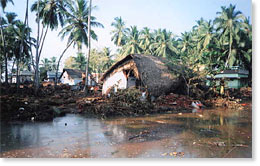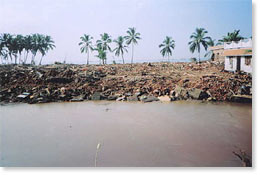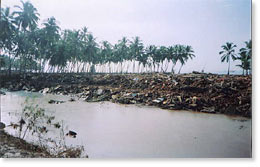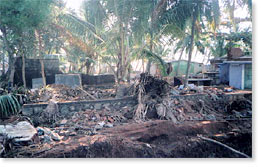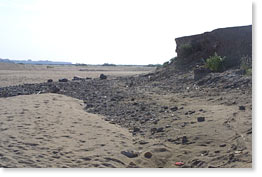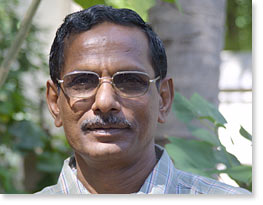|
Tsunami Tragedy in Tamil Nadu: An Appeal For Help To Rehabilitate 2000 Families An in-depth analysis of the devastation by the Tsunami and the re-building efforts of Tamil Nadu organizations of Dalits, farmers, women, workers, and NGOs by L.A. Samy Renganathapuram, Tamil Nadu, India
Dear Friends and Partners in Development The massive tsunami tidal waves that struck the Coramandel (eastern) coast of South Indian states of Tamil Nadu and Pondicherry without warning on December 26, 2004 (Sunday) morning have left a trail of destruction, suffering, and death in its wake in the coastal districts of Chennai, Thiruvallur, Kancheepuram, Cuddalore, Nagapattinam, Thiruvarur, Thanjavur, Thoothukudi, Ramanathapuram, Tirunelveli, Kanyakumari and Karaikal. The latest official death toll is put below the mark of 10,000 as no accurate picture has emerged in some of the worst affected areas. Rescue and relief workers are still searching for bodies among the wreckage. Thousands of people have lost loved ones, their homes, means of subsistence, and their possessions leaving them destitute. Transport and communications besides power and water supply have been severely disrupted. Houses, small businesses, roads and bridges have been destroyed or damaged. Perhaps a third of those killed were children. Many were swept away before the eyes of horrified, helpless parents. The killer waves that moved with ferocious speed across an unprecedented expanse of Tamil Nadu landscape flung their victims about with a randomness that was all but impossible to comprehend. Hundreds of bodies of those who died ended up in trees, or entangled in electrical power lines, or embedded in the mud of hillsides. The grief-stricken continue to throng, clawing through mud and rubble, peering into the faces of the severely injured, wandering through piles of decaying corpses, and digging deep into the mounds of sand in search of loved ones. Despite the effective deployment of the army men, coastal guards under the control of the Union Government and the police and administrative personnel of the State Government of Tamil Nadu, scores of villages marooned by the seawater and mountains of debris still remain unreachable. Imagination pales beside the overwhelming reality the pictures taken in makeshift morgues, particularly on the sandy beaches certainly captured the horror. It looked for the entire world like a sandy playground covered with dead children. The death toll now is more than twice the number of American army men killed in all the years of the Vietnam War. Not just entire families, or extended families, but entire communities were consumed by waters that rose up without warning to destroy scores of thousands of people who were doing nothing but going about their ordinary lives. Any tragedy is awful for the relatives of those who perished. But this is a catastrophe of a different magnitude. What makes it especially frightening is that whole communities have been annihilated. We've known for years now that the emotional devastation that survivors feel and experience is often greater than the physical devastation. With the self-image of being a regional power in South Asia and its pursuit towards the permanent membership in the Security Council of the United Nations, Indian Government has refused any foreign aid, especially from the U.S. Tamil Nadu is witnessing a series of helicopter surveys of the misery in cities, towns and marooned villages by ministers including the Prime Minister. Leaders of almost all the political parties keep visiting the affected areas and ‘consoling the destitute and the deprived.’ .The opposition and the ruling party are raking up disaster-related issues to fight over. Funds for relief operations can also become an issue between the State and Union governments in the coming days. The Chief Minister of Tamil Nadu has asked the Union government to release Rs 48000 million (about US 1100 million dollars) for relief measures. It appears that this amount is abysmally lower than what is actually required in terms of the steps taken to rehabilitate the tsunami victims. According to a preliminary survey at least 5000 mechanised fishing boats in Tamil Nadu have been irretrievably lost or damaged. Each costs Rs 2.6 million. Apart from these thousands of small and medium sized unmechanised boats and catamarans have been turned into useless debris. The number of fishing nets lost to the fiery waves is beyond human comprehension. The infrastructures like roads, bridges, communication system, water and power supply remain incalculably damaged. Only a divine power can calculate the losses suffered by the survivors in terms of the cost of the homes and personal belongings besides valuable documents like school certificates. NGOs, private social service organizations, and individuals Within hours, it must be emphasized, it was the NGOs, private social service organizations and individuals who began massive relief operations. Food packets and garments sent to the affected areas were so massive that they got clogged soon with the Result Mountains of old clothes remain untouched while there were instances of spoiled food packets thrown into the garbage. There has arisen a welter of confusion amongst the service agencies themselves as a number of works were either overlapping with each other or unnecessarily being duplicated. As neither the government agencies nor the non-government ones had any previous experience in dealing with a calamity of such a magnitude such confusions and mistakes were unavoidable. Slowly the service agencies are learning to co-ordinate their activities and co-operate not only amongst themselves but also with the government agencies in order to make sure that their own resources are not wasted and that the government aids are not spirited away by the political middlemen. The Union Government has in its part, besides deploying the army and the Paramilitary forces in relief work, is assessing the extent of damage caused to the lives and property before arriving at both the quality and quantity of the relief and rehabilitation measures. Its damage control bodies have finally woken up to cope with the reality of the immense human tragedy. It is expected that the Union Government would finalise its comprehensive relief and rehabilitation measures shortly. No one is presently sure of the long-term effects of the measures the Union and State Governments are committed to implement. The track record of this government, especially on ecological and environmental issues, generates little confidence in them. Official statements and steps reveal no recognition of the role of environmental degradation in the making of the disaster. Neglect of environment protection The calamity highlights, more than anything else, the callous neglect of environment protection along the entire coastal belt of India, including Tamil Nadu. India, by law, has a coastal regulation zone (CRZ), where building activities are supposed to be strictly regulated. In Tami Nadu and elsewhere, the rules and regulations have been observed more in breach than in observance. The rapacious rich, callous corporate sector, and a state overcharged with the 'free market' spirit have indulged in impermissible real-estate activities in the protected zones supposed to be protected ones. A concrete jungle of residential colonies, posh restaurants, star hotels and entertainment parks has robbed the land of all coastal protection from the once friendly sea. It is mainly the poor who have paid -- with their lives -- for this crime against the coastline. The entire east coast in India is dotted with shrimp farms, a significant number of them already abandoned as economically not viable. The human and environmental costs involved have been immense. While it resulted in acquiring thousands and thousands of acres of cultivable land to turn them into shrimp farms and reducing the total workforce which was otherwise engaged in agricultural works, it was responsible for salinating the lands thus acquired by bringing the sea water to the farms by digging canals from the beaches. The teams sent at the initiative of AREDS involving a number of dalit, farmers, and women and workers organizations with baby food, medicines, new garments etc., to contribute to the relief work undertaken by fraternal NGOs, found that in a number of places, the canals dug to feed the sea water into the shrimp farms have helped the giant waves to make incursions into the land mass. The mangroves along the entire eastern coastline have been systematically destroyed either by the shrimp farms or by the tourism industry. The successive governments have continued to turn a blind eye to the systematic plundering of coral reefs. Significant numbers of environmental NGOs and activists have been crying themselves hoarse over these issues, but the powers-that-be, including a section of the judiciary, have preferred to dismiss them as irrelevant to the onward march to Progress and Prosperity and towards making the country powerful. What lies beneath the callous indifference is the corporate-political nexus of corruption that seeks to thrive on human misery and lives. When the dead have been cremated or buried, it will be time to tell the people that environmentalism is not a favourite hobby-horse of certain elites and that what is at stake in the protection of India's coastal environment are the lives of millions of people sandwiched between the sea and the sky. The Asian Tsunami: Why there were no warnings Much of this death and destruction could have been prevented with a simple and inexpensive system of buoys. Indian Officials have said that an immediate public warning could have saved lives, but that they could not know of the danger because there is no international system in place to track tsunamis in the Indian Ocean. Such a system is not difficult or expensive to install. In fact, the detector buoys that monitor tsunamis have been available for decades and the U.S. has had a monitoring system in place for more than half a century. More than 50 seismometers are scattered across the Northwest to detect and measure earthquakes that might spawn tsunamis. In the middle of the Pacific are six buoys equipped with sensors called "tsunameters" that measure small changes in water pressure and are programmed to automatically alert the country's two tsunami-warning centers in Hawaii and Alaska. The tsunameters each cost only $250,000. Indian Minister of State for Science and Technology Kapil Sibal’s claim that, “If the country had such an alert system in place, we could have warned the coastal areas of the imminent danger and avoided the loss of life” is hardly convincing if one bears in mind the following: At a meeting of the UN (United Nations) Intergovernmental Oceanographic Commission in June last year, experts concluded that the "Indian Ocean has a significant threat from both local and distant tsunamis" and should have a warning network. But no action was agreed upon. Geologist Brian Atwater of the U.S. Geological Survey said, "Sumatra has an ample history of great earthquakes, which makes the lack of a tsunami warning system in the Indian Ocean all the more tragic. Everyone knew Sumatra was a loaded gun." As recently as October 2003, Australian-based seismologist Dr Phil Cummins called on the International Coordination Group for the Tsunami Warning System in the Pacific to extend its reach to the Indian Ocean. All of the sensors, including seismological input, have to be linked to round-the-clock monitoring stations manned by trained scientific staff. Equally important is a program of training and education designed to make officials and the public aware of the dangers and what to do in the event of a warning. The failure to establish such a system is bound up with shortsightedness, inertia and outright contempt -- especially on the part of the major powers -- for the lives of the oppressed masses of southern Asia. Destructive tsunamis are actually more common in the Indian Ocean than in the Pacific Ocean, but none of the G-8 countries borders the region. Both Japan and the United States have spent millions on a string of tsunameters and monitoring stations in the Pacific to protect their coastlines, but, prior to last week’s disaster, neither country offered to pay for its extension to the Indian Ocean. The Indian authorities confronted many of the same obstacles as their counterparts in other countries affected by the tidal waves. But they had one advantage: the Indian air force maintains a base on the remote Andaman and Nicobar islands -- Indian Territory in the middle of the Bay of Bengal situated close to the earthquake’s epicentre. It was not a matter of guessing whether or not a tsunami would form. Shortly after the earthquake, the wave swept over the islands and the air force base. According to a report in the Indian Express, the airbase in Madras received communications from the Nicobar Islands an hour before the tsunami struck southern India. Air Force Chief S. Krishnaswamy told the newspaper: “The last message from Car Nicobar base was that the island is sinking and there is water all over.” The chief instructed his assistant to alert New Delhi, which he did -- by fax -- to the home of the former science and technology minister. No further action was taken and no tsunami warning was issued for Chennai or for other southern coastal towns and cities. As the horrifying toll of death and destruction continues to mount in India and other parts of southern Asia, it becomes ever clearer that lives could have been saved if a tsunami warning system had been in place. With just 15 to 30 minutes notice, and clear directives to flee, many people who had no idea what was happening or how to react, could have escaped to safety. Ironically, the one technology the Indian government keeps priding itself with is the Information Technology which enables our people to sit back and watch in real time, like voyeurs, the life-and-death struggles of our fellow humans. Responding to the Government’s failure the Indian scientist Roddam Narasimha made a caustic remark: “Even if we had the two-hour warning for tsunami, based on scientific data, what would the [Indian] administration do about it? Who would have called whom, and how would they have conveyed the warning to the people?” He pointed out that New Delhi had failed to learn anything from the cyclone that devastated the Indian state of Orissa several years ago. “The administration had a two-day advance warning about the Orissa supercyclone, but what happened? So, could they have done in two hours what they couldn’t do in two days?” Death, destruction and destitution along the coastlines The tsunami catastrophe also raises broader questions. The absence of a warning system for southern Asia is symptomatic of the general state of affairs regarding disasters, such as flooding and cyclones that occur regularly throughout the region. The very scale of the tsunami tragedy has provoked the sympathy of ordinary people around the world, compelling governments to respond, even if insufficiently and belatedly. Yet every year thousands of the ‘wretched of the earth’ die or become homeless as a result of natural disasters but they hardly become the international media events. While these reflections are necessary and inevitable, what stares into our face and troubles us presently is the dark reality of the death, destruction and destitution along the coastlines. Not only that. The farmers in the cultivable lands not far from the sea have also been fallen victims to the tsunami waves. In fact they have been traumatized for the whole of the year -- first, unprecedented drought followed by floods caused by heavy rain falls, and now the incursion of sea water into their paddy and groundnut fields. Thousands and thousands of hectares of cultivable land are in danger of being permanently salinated unless fresh water is pumped into their fields immediately. The collateral damage to the South Indian economy is self-evident. Its fall out is already being felt by the general populace across the country who face the drastic cut not only in the supply of fish in the market, but sky rocketing of prices of meat and other essential commodities. The challenges posed by the tsunami disaster to the Governments of the world, aid agencies, NGOs, charitable institutions, environmental activists and well-meaning individuals are enormous. It has become imperative for all of us, the NGOs, not to lag behind anyone in rushing things immediately needed for those whose very survival is at stake and co-ordinate our activities with others both in government and non-government sectors to see the immediate relief and rehabilitation measures reach out to those who cry for help. Federation of Karur People’s Movement With this in view, the Federation of Karur People’s Movement organized a meeting on 29.12.2004 at SWATE office with the participation of the following voluntary organizations and people’s movements:
After passing a resolution condoling the death of thousands of people in tsunami disaster, the participants of the meeting unanimously decided after ascertaining from the our two coastal area partners (voluntary organization, member organization of Women MAPOVI, Tamil Nadu ) what were the articles needed most. Accordingly the following materials were collected from the members of the above organizations and movements: rice, garments, food article. The following materials were bought afresh out of the contribution of Rs 1,000,000 contributed by AREDS and another Rs 50, 000 by the People’s Movements: Biscuits for the children, bed sheets, and towels, inner garments for women, men’s wears, saris and dhotis. 12,162 members of the women’s organization SWATE have agreed to contribute one day wages for further relief work. Similarly, the members of the People’s Movements Sangamam, Vensudar and Dalits Rights Awareness and Liberation Movement (DRALM) have also agreed to contribute one day wages for the relief work. The Farmers’ Associations Forum for Protection of Water and Livelihood Resources and Lift Irrigation Farmer’s Association will contribute a minimum of Rs.5000 each towards relief assistance. The members of the staff of AREDS will contribute their one day salary towards relief measure.
Observations by two teams of volunteers On 30.12.2004, two teams of volunteers set off from SWATE, Veerarakkiam, Karur – one to Nagapattinam and Thiruvarur districts and another to Kanyakumari. .L.A. Samy, Director of AREDS, and S.V. Periyasamy, Leader of Farmer’s Association, flagged off 2 lorry loads of the above relief materials collected and bought afresh to the tsunami affected people in Nagapattinam, Tiruvarur and Kayakumari Districts. The members of our team were requested to, besides distributing the articles to the victims of seismic waves either directly or through the volunteers of the fraternal NGOs doing relief work, do on-the-spot study and record their impressions as to the magnitude of the calamity and the relief measures being taken up. Some of the observations made by the members of the team that went to Kanyakumari district with relief material are given below:
There are some crucial observations made by the members of the Team:
“We have decided to adopt 2000 families” In view of these observations and findings, at the initiative of AREDS a Collective consisting of members of the voluntary organizations and peoples movements mentioned above, 25 NGOs in Trichy district and the leading activists of Women MAPOVI-TN from all over Tamil Nadu has been constituted and its members are being sent to all the affected town and villages in Tamil Nadu with a questionnaire to collect the required information to arrive at a clear picture of losses caused to human lives and their property. It has also been decided to work with Coastal Action Network, a cluster of NGOs dealing with peoples and issues (including the environmental issues) in the coastal regions of Tamil Nadu in all the relief measures it undertakes independently or with government agencies or with the Federation of Fishermen Association of Tamil Nadu so that any activity related to the relief work is not duplicated or improperly channelised. The members of the team would also spend 7 to 10 days with the relief agencies in works such as looking for the dead bodies and disposing them, searching for those considered to be alive and retrieving them, and distributing relief materials. Union Government would soon come out with its packages for relief and rehabilitation of the victims of tsunami. The State Government of Tamil Nadu may get sizeable, if not the entire amount, demanded from the Union government. There would be a flurry of activities for some time to come. Then, if our past experiences are an indicator, the relief and rehabilitation work would become bureaucratized, sink into corruption and nepotism and get charged with discrimination based on caste and communal bigotry. Voluntary Organizations like us, feel that rushing relief materials to the affected people and rendering physical help has to be prioritized at present. We should also think in terms of long term policy for rehabilitating the victims. It is not an easy task. They need to get back to their work. They need a house to shelter them. They need their means of subsistence -- trawlers, boats, nets and other implements. Infrastructures have to be rebuilt -- roads, water and power supply and telecommunication, schools, medical centers and so on. There are thousands of such people who need these. AREDS, independently or as partner in a network of likeminded NGOs can not do all these. As the proverb goes no man is up to his task. Our desire, aim and commitment are very modest. We have decided to adopt 2000 families in the far flung, remote and generally neglected (even during normal days) villages in three coastal districts of Nagapattinam, Thiruvarur and Kanyakumari districts of Tamil Nadu where we have dedicated members and volunteers, who, if provided with the required means, will leave no stone unturned to fulfill the tasks and duties assigned to them. It is not enough to console ourselves that our fellow humans are desperately drawing upon the deepest reservoirs of fortitude and resilience that our troubled species has at its disposal. The rehabilitation work even at a modest scale we are planning may seem formidable. But the recovery process would become easier, when there is a supportive community to bolster those in need. Our planet is growing smaller and smaller everyday and its inhabitants more interdependent by the day. This immense calamity would at least have a silver lining if it moved the people of the more fortunate parts of the world toward a wiser, more genuinely cooperative international concern. We know that these parts of the world are not short of supportive communities. We only expect their sentiments of solidarity and support are translated at the earliest into concrete contributions to help us realize our modest rehabilitation plans. Your contribution can be sent to:
The Contribution can be made in International Cheque and sent to AREDS address:
Also read:
Published in In Motion Magazine January 8, 2005 |
||||||||||||||||||||||||||||||||||||||||||||||||||||
If you have any thoughts on this or would like to contribute to an ongoing discussion in the  What is New? || Affirmative Action || Art Changes || Autonomy: Chiapas - California || Community Images || Education Rights || E-mail, Opinions and Discussion || En español || Essays from Ireland || Global Eyes || Healthcare || Human Rights/Civil Rights || Piri Thomas || Photo of the Week || QA: Interviews || Region || Rural America || Search || Donate || To be notified of new articles || Survey || In Motion Magazine's Store || In Motion Magazine Staff || In Unity Book of Photos || Links Around The World NPC Productions Copyright © 1995-2020 NPC Productions as a compilation. All Rights Reserved. |


